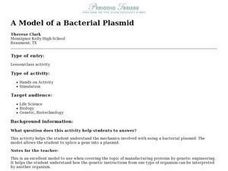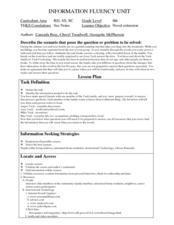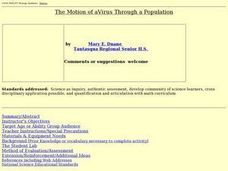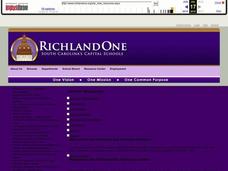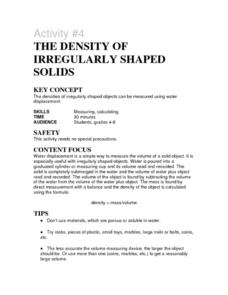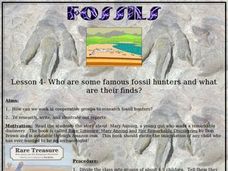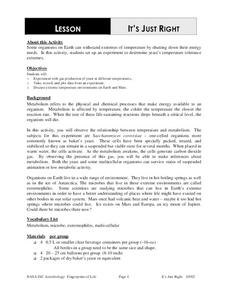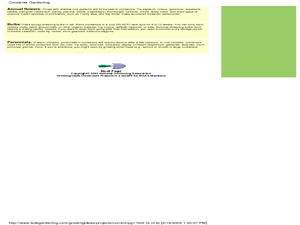Curated OER
Battle of the X-Planes
Students view a video about cost of materials. They work together to develop their own backpack taking note of the cost of materials. They create an advertisement to accompany their creation. They share their ideas with the class.
Curated OER
A Model of a Bacterial Plasmid
Young scholars construct a plsmid model with the materials provided and be able to use it to define certain terms and explain other practical applications of genetic engineering. This simulation allows the students to work through the...
Curated OER
Novel Extension
Sixth graders play the role of meeting Tuck Everlasting. They prepare to answer that person's questions. They determine that each member of the family wants to know about a different thing.
Alabama Learning Exchange
Learning the Three Layers
Learners examine the Earth's crust or lithosphere, mantle and core. They complete research using assigned web sites before designing a model of the Earth using items such as Play-Doh, peaches and apples.
Curated OER
The Motion of a Virus Through a Population
Students test the factors that influence the rate at which a virus spreads through a population. They complete a lab activity then discuss data collected and review and answer a set of questions.
Curated OER
"Teaching escape plan with Get Down Low and Go Go Go"
Students recall the flashcards from the day before, to aid in memorishing this procedure. They recall the sound of a smoke alarm. Sudents are taught and use the fire safety procedure of Get Down Low and Go, Go, Go. They demonstrate their...
Curated OER
Let There Be Light!
Fourth graders conduct experiments involving reflected light, absorption of light, refracted light, and colors absorbed by light. In this light lesson plan, 4th graders write about the results of their experiments as well.
Curated OER
The World of Neonatal Nursing
Students explore the world of neonatal nursing. They research all the qualifications to becoming a neonatal nurse. Students unveil what neonatal nursings affect on the environment is.
Curated OER
Activity #4 The Density of Irregularly Shaped Solids
Young scholars comrehend that water displacement is a simple way to measure the volume of a solid object. They pour water into a graduated cylinder or measuring cup and its volume is read and recorded. Pupils the volume of an object by...
Curated OER
Heat Pollution and Communities
Students examine thermal pollution by collecting temperature data on the school's photovoltaic panel. Students collect data for four consecutive days and retrieve information from other classes that meet at different times of the day. ...
Curated OER
Transition Metals
Students identify and describe transition metals. They discuss alloys and their benefits. Students research one common, alloy, its composition, properties, and uses. They are asked for some common properties of most transition metals....
Curated OER
Sprinkles 5
In this environment worksheet, students read the information and complete the survey about their own local habitats and some of the others in Florida.
Curated OER
Acid or Base? Toxie's On The Case!
In this chemistry worksheet, students read about the differences between substances that are acids and bases. They read about Litmus dye and the pH scale. They experiment with six household substance by testing them with litmus paper to...
Institute of Electrical and Electronics Engineers
Shipping For Survival
Students explore package engineering and investigate design. In this shipping instructional activity students are given a flower and are to come up with a packaging that will allow the flower to get to its destination as fresh as...
Curated OER
Fossils Lesson 4 - Who Are Some Famous Fossil Hunters and What Are Their Finds?
Students research and develop a presentation about a famous fossil hunter/archaeologist. In this fossil hunter/archaeologist lesson, students listen to a reading of Don Brown's, Rare Treasure: Mary Anning and Her Remarkable Discoveries....
Curated OER
Swimming With the Crabs
In this expository writing worksheet, students read an article about crabs and a graphic organizer with crab facts. Students fill in a graphic organizer, including their specific topic about crabs and details to support their topic.
Curated OER
Fluke: Whale Watching Activity
Sixth graders observe and record data about humpback whales in Hawaii. For this humpback whale watching lesson, 6th graders watch the activity of whales from a Hawaiian beach. They record data about their behavior and complete a research...
Curated OER
Defining Culture
Students explore cultural diversity. In this cultural awareness lesson, students examine the similarities and differences in various cultures and discuss the value of these differences.
Curated OER
It's Just Right
Students conduct an experiment to determine the temperature tolerance of yeasts. In this biology lesson, students collect data and compare them by plotting graphs. They explain how extreme temperatures affect organisms.
Curated OER
Butterfly Lifecycles
What a great way to present this topic! While a little difficult to follow, this activity provides great ideas for a second grade activity involving butterfly lifecycles. Learners make drawings of butterflies, discuss life cycles, and...
Curated OER
What does 'Endangered' mean?
Learners discuss a variety of teacher led discussion questions about what makes an animal endangered. They take a short field trip to an open area and set a boundary for each child for them to either write or draw about how the location...
Curated OER
Gardening in Containers
Young scholars plant a garden. In this gardening instructional activity, students use containers to plant a garden. This instructional activity provides a good source of information for teachers who wish to begin their class's own...
Curated OER
Plant Parts
Second graders conduct research on plant parts. They listen to the book "Jack and the Beanstalk," explore various websites and read about plant parts, and create a movie using Kid Pix computer software.
Curated OER
Hatching Chickens
Students explain the importance of carefully observing and caring for eggs and chickens in the classroom.



